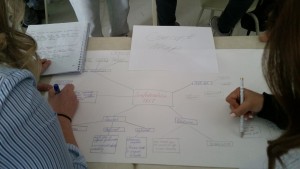Concept-Mapping
The power of a good team-building concept map should not be overlooked. When students are asked to work together to link ideas and thoughts for a particular historical event, great things happen. Concept-mapping is also a great skill to possess, and often, students will concept map beside their class notes as an added, personal visual aid. Below are some blank concept maps to start with.


My Teaching Philosophy
The Purpose of Education
As it is difficult to elaborate and define one’s personal teaching philosophy, it is equally challenging to define education. Education has evolved with time; for instance, in the 1990s, a prevailing view was that schools should focus on student performance in order to increase educational output (Crump, 2005, p. 44). Though an emphasis on student performance and productivity may have sufficed a couple of decades ago, education has been reshaped since then. On a historical level, it can be said that as society became more complex, education itself changed to become less dogmatic and, by extension, less confident in its ever changing purpose (Wiens, 2013, p. 13). In my opinion, there is nothing wrong with the changing state (and even uncertain state) of education because a key characteristic of education is that it necessitates change and development throughout the ages. Every generation requires a different kind of education and for this reason, it is important for education to have as a distinguishing trait the ability to be both changing and resilient. Resiliency in education is significant because what is at the core of education should not have to crumble as a result of changing worldviews and times. The purpose of education, which is perhaps more timeless than how education is defined, relies largely on the idea that education and learning should be tailored to everyone. In other words, the purpose of education is for everyone to be able to realize his or her own potential in learning. The purpose of education should not be to ostracize students who learn differently and reward those who do well in assessments, but instead, to bridge the gap between differences in learning so that education has an effect on everyone.
A teacher is situated very closely in the center of this purpose. It is a teacher’s responsibility to ensure that his or her students feel comfortable learning. More importantly, it is a teacher’s task to allow students to be aware of their potential. Potential is sometimes overlooked in education; students are either deemed successful or unsuccessful without understanding that their grades do not necessarily determine their future. It is essential to emphasize the idea that each student has the capacity to develop into something in the future that is meaningful to him or her.
Effective Teaching: Methods and Approaches
In schools, students are not always taught to understand their potential. While education is diverse, it also stratified and fragmented in that some students have fewer opportunities in education because of their backgrounds (Sields, 2006, p. 473). In addition, rather than being treated as people with potential, students are often dismissed as “widgets or fungible items, each experiencing education in the same way…and demonstrating learning on the same standardized test” (Ibid). In my opinion, family background, ethnicity, religious leanings, or test scores should not have to hinder a person’s opportunity to learn. It is dangerous to keep reproducing an educational system that perpetuates the inequities that arise from the idea that all people learn in the same way and some emerge from education in success while others do not. In an attempt to stray away from reproducing this type of education, I believe in the benefits of transformative teaching. According to Carolyn M. Shields, transformative teaching and leadership “permits us to challenge […] inequities in the status quo” and “offers the promise not only of greater individual achievement but of a better life lived in common with others” (Ibid). Being a transformative teacher means providing learning opportunities for all students and understanding what Freire meant when he wrote: “education is not the ultimate lever for social transformation, but without it transformation cannot occur” (Freire, 1998, p. 37).
A transformative approach to teaching is the most effective way to foster growth in students because a transformative teacher would not base a student’s capabilities on their differences or ethnicity. This kind of teacher would also need to recognize that the ways in which most schools are organized legitimizes and marginalizes some practices (Shields, 476), but that this is not conducive to learning. Moreover, a transformative teacher would understand that it is necessary to question and think critically of what others have regarded as “valid knowledge” (Shields, 478). After all, education is political and transformative teachers should come to terms with how “invisible decisions” based on school politics have decided the ways in which knowledge is transmitted and assessed (Shields, 478). Overall, transformative teaching has as its goal the critiquing of current educational systems and, most crucially, the promise of something better and more inclusive for students.
It is important for the transformative teacher to recognize their goals, as it is equally important that these goals be communicated to students. One of the most important approaches to transformative teaching is ensuring students are aware and critical of the suppositions and statements that are considered to be “true” in education. It is my belief that teaching methods should also include encouraging participation, opening up a venue for discourse and dialogue, and inspiring independent thought. This would be best exemplified through activities such as concept mapping, journaling, discussions, role-playing, and more. Ideally, activities would oftentimes include working with a team. The end result would be that the teacher creates a trusting environment for students where learning, change, and reflection are at the forefront of education.
Effective Learning: Methods and Approaches
As a teacher, understanding effective teaching in a transformative framework is a key part of cultivating learning. However, it is just as essential to understand effective learning. In my opinion, meaningful learning is achieved with the help of the attitudes and mindsets of students. Students should welcome diversity and promote qualities such as respect and responsibility. While a teacher plays his or her own role in shaping the classroom environment, students are integral to maintaining this environment. Learners should be able to construct and deconstruct knowledge while also encouraging others to do the same. This is perhaps the first and most essential part of effective learning; it is a communal task to create a transformative classroom and while creating one begins with the teacher, students conserve it. For instance, in a classroom where openheartedness, diversity, respect, and responsibility are lacking, students may approach an Arab student who brings tabouleh to class with impolite comments. The student may emerge from this situation ashamed of his or her ethnicity and as a result, their capacity to learn and grow could be compromised by the fear that they are different.
While learners should develop openheartedness, respect, and responsibility within the classroom, they should also act as keenly participating members of the classroom. Effective learning relies on this kind of activity. This includes participating in discussions and critically examining different kinds of viewpoints for any given topic. Without active participation, the classroom devolves into a space where the teacher is tasked with lecturing and the students become professional note-takers. While lecturing is effective in some situations, it not always an ideal approach to learning. If students have created a comfortable classroom environment, discourse should occur organically. With time, this kind of learning would allow students to recognize that participation is a requisite of good communication skills.
Personal Teaching Goals
It is my belief that teachers should not remain silent on issues of importance. Though it may be easy to follow the status quo, it is ultimately a detriment to students. A large part of my personal teaching objective has to do with making decisions that enact change and using my agency as a teacher for the better. I have adapted much of my personal teaching philosophy from transformative leadership and the idea that leading for diversity consists of choosing a side “to ensure that educational decisions no longer perpetuate social inequality” (Shields, 480). For me, one major aspect of taking sides includes standing up for democratic values in the classroom while opposing repressing and homogeneous classroom settings. For example, E.J. Weiner suggested that one of the responsibilities of a transformative teacher is the reorganization of political space and to understand the relationship between leaders and learners dialectically (Weiner, 2003). This resonated with me, especially when reminded of the structure of classrooms in most school settings. For example, classrooms are oftentimes organized in such a way where advantaged students are in advanced classes while minority students are in remedial classes (Shields, 2006). Teachers should question this separation of students and make an effort to deconstruct it fruitfully by speaking with students about their experiences and observing classroom environments. Teachers may find that it is in fact a disservice to students to separate them based on their socioeconomic background because making a distinction based on social class is yet another way students learn to reject diversity and differences. Thus, it would be my personal teaching goal to reevaluate the way students are placed in classrooms based on their apparent strengths and weaknesses. On a grander scale, I feel as though it is important to break the silence on a lot of issues that tend to be swept under the rug. For example, it is just as important to recognize that white students may feel left out when speaking of diversity. As a teacher, I would emphasize the significance of all students’ backgrounds and make an effort to give a voice to those who feel as though they should remain uncommunicative on certain issues. Overall, much of my own philosophy of teaching is grounded in a philosophy of education that stresses transformative teaching. My personal teaching goals would thus best be summed by Weiner’s claim that a teacher should exercise their power in a way that begins with questioning commonly held beliefs and reflecting on things such as justice, democracy, accountability, and social responsibility (Weiner, 2003, p. 89).
References
Crump, S. (2005). Changing times in the classroom: Teaching a crowded profession.International Studies in Sociology of Education, 15(1), 31-47.
Freire, P. (1998). Pedagogy of freedom: Ethics, democracy, and civic courage. Lanham, MD:Rowman and Littlefield.
Shields, C.M. (2009). Administration, Leadership, and Diversity: Reproduction or Transformation? New York: Peter Lang Publishing Inc.
Weiner, E.J. (2003). Secretary Paulo Freire and the democratization of power: Toward a theoryof transformative leadership, Educational Philosophy and Theory, 35(1), 89-106.
Weins, J. (2013). Bridging the grand chasm. In K. Goodnough, G. Galway, C. Badenhorst and R. Kelly (Eds.), Inspiration and innovation in teaching and teacher education. Toronto, ON: Lexington Books, (pp. 9-26).
Competencies
Take a look at how I relate to the Quebec Education Program’s competencies!



